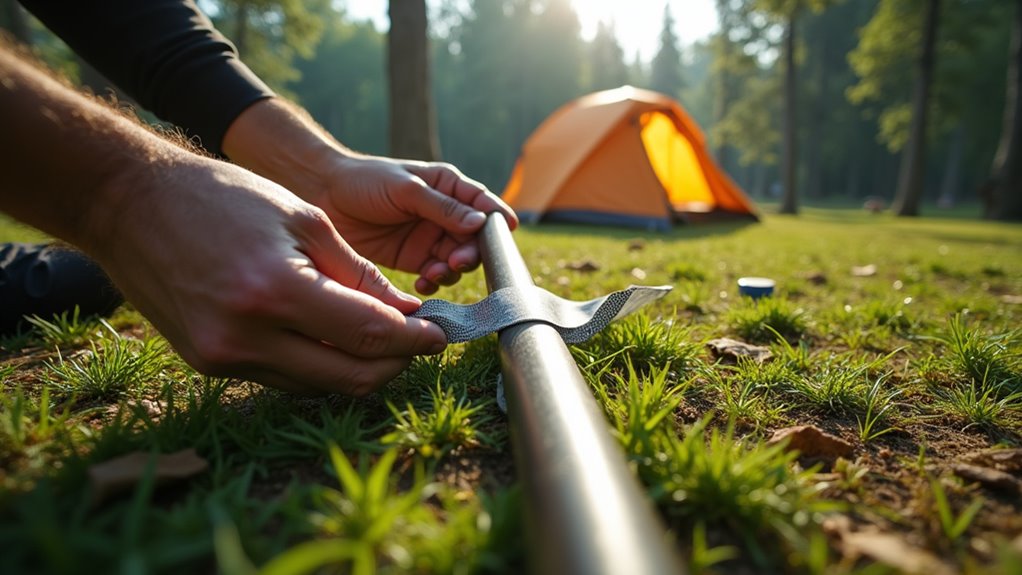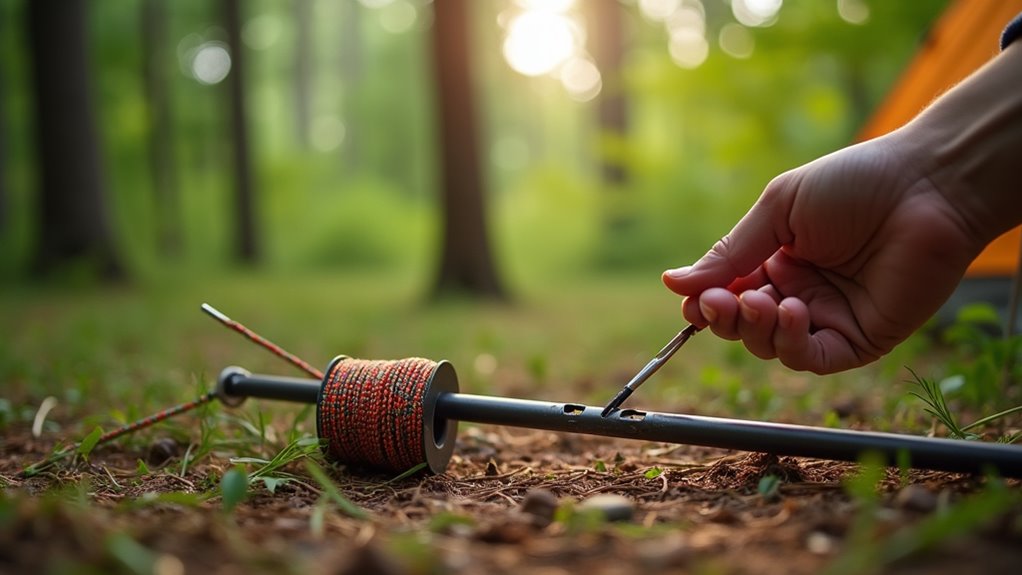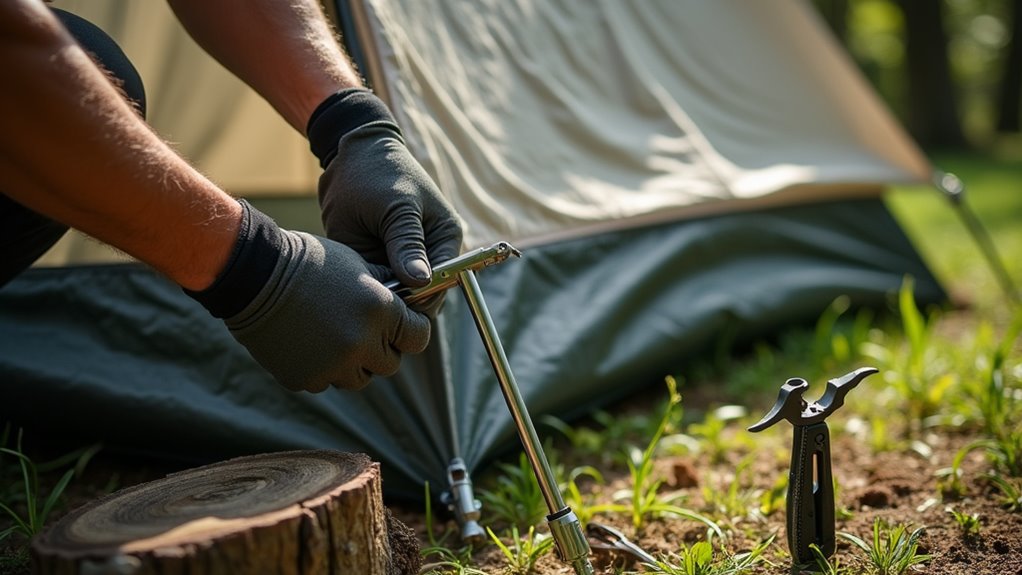How To Fix A Snapped Tent Pole
This post contains affiliate links. As an Amazon Associate, we earn from qualifying purchases.
To fix a snapped tent pole, align the broken ends and secure them using a splint like a plastic bottle piece or tent stake, wrapped tightly with duct tape. If you don’t have a splint, pressing the pole sections together and firmly wrapping them with strong tape can also work. Cleaning the ends before taping helps improve adhesion. This quick repair will stabilize your tent until you can access more permanent solutions. Further explanation and detailed tips on tent pole repairs are provided below for those interested.
Essential Facts in 30 Seconds
- Align broken pole ends tightly and straight before repair.
- Use a plastic bottle piece or tent stake as a splint secured with duct tape.
- If no splints are available, wrap broken parts firmly with strong tape.
- Clean pole ends before repairing for better adhesion.
- Use gaffer’s or duct tape for a quick, temporary fix.
Quick Field Fixes for Snapped Tent Poles

Snapped tent poles need quick fixes to keep your shelter standing. First, line up the broken ends straight and tight.
Cut a piece from a plastic bottle to use as a splint. Wrap this splint around the break and secure it with duct tape or electrical tape. A tent stake can also work as a splint. Place it beside the break and tape it firmly.
Without splints or stakes, press the broken parts together and wrap them tightly with strong tape. Clean dirt and dust from pole ends before fixing. Addressing broken poles ensures your tent remains stable until a more permanent solution can be applied. Using a patch kit can help repair other damaged areas of your tent fabric.
These quick repairs help your tent stay up but mightn’t pack neatly. Stay prepared with tape and small tools for camping trips.
Replacement Pole Section Preparation and Installation
Replace a snapped tent pole section carefully for best results.
First, measure the broken piece and replacement pole. Make sure the length matches exactly. Often, you need to cut the replacement pole. Wrap masking tape around the cut area to stop splinters. Use a fine-toothed saw to score the fiberglass for a clean break. Mark the cut line with a permanent marker.
Next, untie knots on the shock cord to remove the broken section. Keep the good parts threaded to keep pole shape. Remove any end caps or ferrules for easier pulling.
Insert the new pole section in the right direction. Connect male and female ends correctly. Addressing issues promptly is essential, so tighten the shock cord but don’t pull too hard. Ensure the joint can withstand wind or other forces during camping.
Finally, check the pole assembly for strength. Adjust if needed to make sure it fits well. This way, your tent stays sturdy and ready to use.
Repairing Tent Pole Elastic Cord

Repair the elastic cord in your tent poles to make them last longer. Sagging or hard-to-assemble poles need new cords.
Take the poles apart by pulling each section after cutting the old cord. Use a 1/8-inch elastic cord for best results. Push the new cord through each pole section. Use a stiff wire or rod to help thread the cord straight. Make sure the cord runs evenly on both sides.
Pull the cord tight enough to hold the pole sections firmly. Leave some slack so you can take the poles apart easily. Tie a strong figure-eight knot at each end. Check the tension before tying the knots. Cut off extra cord after tying.
Check the cord often for signs of wear or damage. Store poles dry and apart to stop cord damage. Keep extra shock cord ready for quick fixes.
This simple care will keep your tent poles working well for many trips.
Adhesives and Tape for Temporary Repairs
Temporary repairs on tent poles work well with adhesives and tape. Use epoxy like JB Weld for a strong metal bond. Liquid adhesives such as Seam Grip suit fabric patches. Clear silicone caulk mixed with mineral spirits fixes small cracks cheaply.
Tape options include gaffer’s tape or duct tape for quick support. Tenacious Tape™ works best on tent fabric holes. Clean and dry the surface before applying tape. Cut tape edges round to avoid peeling.
Align broken parts carefully. This makes the repair last longer and stops more damage. Follow these tips for a simple, reliable fix on your tent pole.
Handling Different Tent Pole Materials

Tent pole materials affect repairs and how well the tent lasts.
Aluminum poles weigh less, making them easy to carry. They don’t rust easily and last a long time in wet weather, which is essential for maintaining tent durability.
Steel poles are stronger and stiffer. They work well for heavy tents but weigh more and can rust.
Composite poles bend more and resist breaking. They might fail under heavy snow or strong wind.
Carbon fiber poles are very light but can break if bent too much.
Fiberglass poles cost less but break more often.
Each type has pros and cons. Knowing this helps you fix or replace poles the right way. Additionally, understanding tent material differences can enhance your overall camping experience and guide your choice of tent poles.
Frequently Asked Questions
How Do I Prevent Tent Poles From Snapping in the First Place?
Prevent tent poles from snapping by handling them gently. Check poles often for cracks or weak spots. Use poles made from strong materials like aluminum or fiberglass. Store poles in a dry place to keep them from warping. Keep shock cords tight but not too tight to avoid stretching. Temperature changes can make cords loose, so adjust them as needed. Taking these steps helps poles last longer and keeps your tent safe.
Can I Use Any Tape for Temporary Repairs?
Duct tape and gorilla tape work well for quick fixes. Check if the tape sticks well to your tent fabric first. Gorilla tape usually holds stronger and lasts longer in tough spots. Both tapes can stop leaks and tears temporarily. Keep in mind, these tapes are not permanent solutions. Replace or fix your tent properly as soon as possible.
What Symptoms Indicate Pole Elastic Needs Replacement?
Visible fraying on the elastic means it needs replacement. Poles slipping apart easily show weak elastic tension. Harder pole assembly signals the elastic cord is worn out. Elastic that stretches too much loses strength and control. Replacing it keeps your poles strong and safe. Don’t wait for elastic to break during use. Regular checks help catch wear early. Stay ready and avoid gear failure.
How Long Can Temporary Fixes Last Before Needing Permanent Repairs?
Temporary fixes usually last from a few days up to one week. They work like band-aids, stopping problems for a short time. Watch for signs of damage or wear. Once you see them, switch to permanent repairs quickly. Permanent fixes keep things strong and safe longer. Delaying repairs can cause bigger problems and cost more money. Act fast to save time and avoid trouble.
Are There Any Environmental Considerations for Tent Pole Repairs?
Tent pole repairs can affect the environment. Use materials that do not harm nature. Fix poles instead of throwing them away. This reduces trash and saves resources. Using recycled or biodegradable tape and glue helps too. Small actions like these protect forests and wildlife. Keeping gear longer lowers waste and pollution. Every repair counts for a cleaner planet.
Conclusion
Fixing a snapped tent pole is easier than you think. Use duct tape or a pole repair sleeve for quick fixes. Carry spare parts to avoid trouble during your trip. Replace broken sections with the right size poles if possible. Glue works well for small cracks but takes time to dry. A strong patch keeps your tent stable and safe. Small breaks don’t have to stop your adventure. Stay prepared and enjoy the outdoors without worry.
